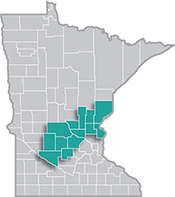 Central Minnesota is a manufacturing stronghold, with several global manufacturing firms operating there.
Central Minnesota is a manufacturing stronghold, with several global manufacturing firms operating there.
The region is especially well known for its expertise in food processing, printing, furniture manufacturing, appliances, machinery and heavy equipment manufacturing.
View our latest blogs on CareerForce. Want the freshest data delivered by email? Subscribe to our regional newsletters.
8/22/2023 9:00:00 AM
Luke Greiner
After gaining almost 60,000 new residents since 2010, Central Minnesota saw a faster population growth than the state as a whole. All but two of the 13 counties in Central Minnesota managed to gain population over the past 12 years, providing a net gain of 59,172 people, for an 8.7% increase, compared to 7.8% for Minnesota. A growing population is the most important way for labor force growth to occur and a leading indicator of future labor force trends.
The largest population gains happened in Wright County (+23,303) and Sherburne County (+12,325), both counties that are positioned on the western edge of the Twin Cities and have benefited from urban expansion along the I-94, Highway 10 and Highway 55 corridor as workers look to gain access to the Twin Cities from outlying suburbs and communities.
The fastest growth was clearly in Wright County, growing by 18.7% from 2010-2022, followed by Sherburne (+13.9%) and Isanti (+13%). A notable trend is the slower growth in Stearns County. Containing the vast majority of the St. Cloud metropolitan statistical area, Stearns has the largest population of any county in the region but grew by a modest 6.5%, slightly slower than the region overall. At the far ends of the region, Renville and Pine were the only two counties that saw a decline over the period, amounting to combined loss of roughly 1,500 people.
| Table 1. Population Change 2010-2022 | ||||
|---|---|---|---|---|
| Area | 2010 Population | 2022 Estimates | 2010-2022 Change | |
| Number | Percent | |||
| Central Minnesota | 684,001 | 743,173 | +59,172 | +8.7% |
| Region 6E | 117,920 | 118,574 | +654 | +0.6% |
| Kandiyohi Co. | 42,239 | 43,839 | +1,600 | +3.8% |
| McLeod Co. | 36,651 | 36,714 | +63 | +0.2% |
| Meeker Co. | 23,300 | 23,376 | +76 | +0.3% |
| Renville Co. | 15,730 | 14,525 | -1,205 | -7.7% |
| Region 7E | 163,789 | 173,904 | +10,115 | +6.2% |
| Chisago Co. | 53,887 | 57,988 | +4,101 | +7.6% |
| Isanti Co. | 37,816 | 42,727 | +4,911 | +13.0% |
| Kanabec Co. | 16,239 | 16,463 | +224 | +1.4% |
| Mille Lacs Co. | 26,097 | 27,280 | +1,183 | +4.5% |
| Pine Co. | 29,750 | 29,446 | -304 | -1.0% |
| Region 7W | 402,292 | 450,695 | +48,403 | +12.0% |
| Benton Co. | 38,451 | 41,463 | +3,012 | +7.8% |
| Sherburne Co. | 88,499 | 100,824 | +12,325 | +13.9% |
| Stearns Co. | 150,642 | 160,405 | +9,763 | +6.5% |
| Wright Co. | 124,700 | 148,003 | +23,303 | +18.7% |
| Minnesota | 5,303,925 | 5,717,184 | +413,259 | +7.8% |
| Source: U.S. Census Bureau, Population Estimates | ||||
Through this time period, roughly 83% of population growth occurred from domestic migration and a natural increase (more births than deaths), while the remaining 17% of the region's increase can be attributed to net migration of immigrants born outside the U.S. The largest influx of immigrants came from Africa (7,653 immigrants), followed by Asia (1,504) and Central and South America (1,500).
Looking towards the future, Central Minnesota's population growth is projected to slow. According to projections from the Minnesota State Demographic Center, the Central region is expected to expand 6.3% from 2025 to 2035, and another 4.5% from 2035 to 2045, though that is half the rate it experienced in the past decade.
Contact Luke Greiner, Labor Market Analyst, at luke.greiner@state.mn.us